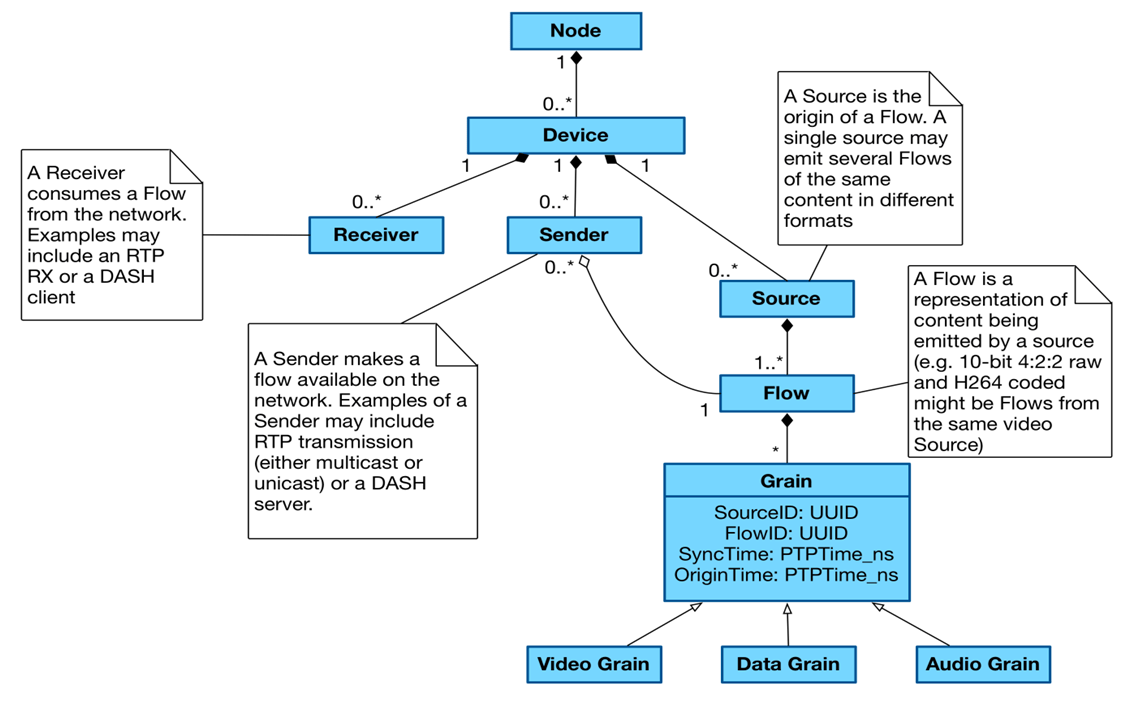本文翻译了AMWA对于NMOS的术语表,供大家更好的理解NMOS中各个参数的定义。
原文链接: https://specs.amwa.tv/nmos/branches/main/docs/Glossary.html
NMOS 术语表
In NMOS specs several common terms have specific meanings that you should be aware of. Many of these correspond to the glossary of the JT-NM Reference Architecture.
在 NMOS 规范中,您应该注意几个常用术语的特定含义。其中许多对应于JT-NM 参考架构的词汇表。
Several of these are formally defined in NMOS specs, but are described here for convenience.
其中一些已在 NMOS 规范中正式定义,但为了方便起见,在此处进行了描述。
Device
A Device is a logical block of functionality within a networked media infrastructure. Example of Devices could include:
设备是网络媒体基础设施内的逻辑功能块。设备示例可能包括:
- Camera
- SDI to IP adapter
- Chroma keyer
- Audio mixer
A Device may have a permanent presence on its Node (Fixed Device, e.g., a networked camera), or it may be created on demand by its Node (Virtual Device, e.g., a software-based transcoder). Nodes may dynamically create different types of Device (Dynamic Device).
设备可以在其节点上永久存在(固定设备,例如联网摄像机),或者可以由其节点(虚拟设备,例如基于软件的转码器)按需创建。节点可以动态创建不同类型的设备(Dynamic Device)。
Flow
In the IS-04 and IS-05 specifications a Flow refers to a sequence of video, audio or time-related data. This is a relatively high-level usage of the word, and should not be confused with a low-level flow within the physical network.
在 IS-04 和 IS-05 规范中,流是指视频、音频或时间相关数据的序列。这是该词的相对高级用法,不应与物理网络内的低级流混淆。
Grain
NMOS specifications use Grain as a convenient way of identifying a unit of video, audio or time-related data. This helps with mapping NMOS’s logical data model onto physical Specifications. For example a frame of video may correspond to a VideoGrain.
NMOS规范使用Grain作为识别视频、音频或时间相关数据单元的便捷方式。这有助于将 NMOS 的逻辑数据模型映射到物理规范。例如,一帧视频可以对应一个 VideoGrain。
Node
A Node is a logical host for Devices. This can be physical, or virtual (and a Node can be within a “cluster” or “cloud”).
节点是设备的逻辑主机。这可以是物理的,也可以是虚拟的(节点可以位于“集群”或“云”中)。
Receiver
A Receiver consumes a Flow from a Sender.
接收者消费来自发送者的流。
Sender
A Sender makes a Flow available on the network
发件人使流在网络上可用
Source
A Source represents the logical primary origin of one or more Flows.
Note that (despite its name) a Source is:
- NOT a Device from which the content originates (for example there might be video, audio and perhaps data Sources associated with a camera, the camera itself is NOT a Source).
- NOT about the physical origin of the Flows (for example: two Flows associated with the same Source might physically originate from different hardware in distinct geographical locations)
源代表一个或多个流的逻辑主要来源。
请注意(尽管它的名字)一个来源是:
- 不是内容来源的设备(例如,可能有视频、音频和可能与相机相关联的数据源,相机本身不是源)。
- 与流的物理来源无关(例如:与同一源关联的两个流可能在物理上源自不同地理位置的不同硬件)
附一: NMOS各个字段定义逻辑图如下

